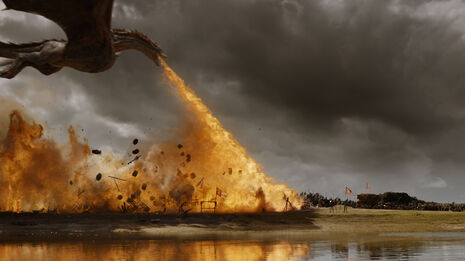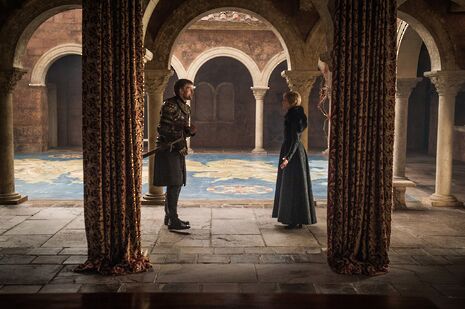Game of Thrones review: fading of the ‘Light of the Seven’
Lillian Crawford finds the latest season of Thrones ultimately a step down from heights it had previously reached, despite clear production improvements

As Arya came upon the familiar airs of Ed Sheeran in the depths of the forest, the premiere of the seventh season of Game of Thrones seemingly fell a victim of its own popularity. Following suit, intricate plot and subtlety disappeared, banished far beyond the Wall by wannabee fans bearing t-shirts of characters whose sigils they would not recognise.
Monologues and diplomatic discussions shortened while battles lengthened, plagiarising the cinematic adaptations of Tolkien in its dragon-repellent crossbows and multiple endings. Indeed, as with the eagles of The Lord of the Rings, Queen Dany’s fiery deus ex machina has grown as tiresome as Ramin Djawadi’s accompanying score.
“Instead the series faded to black on a sea of death metal album cover art.”
Perhaps such criticism of what has been continuously described as the “most explosive” season yet is unduly harsh, and there has been no shortage of entertainment. From Drogon gliding over lakes to Bran’s ravens soaring through Icelandic tundra, the visuals are never short of breath-taking, and those extra months of toil spent in post-production have evidently not gone to waste. Both ‘The Spoils of War’ and ‘Beyond The Wall’ were undoubted high points for the artistic team, and will most likely guarantee awards nominations aplenty. Unfortunately, it may be that too much attention to the exterior has rendered its substance weaker than ever before.
These attributes are not what original fans of the series came to love, satisfied in the opening seasons by Dubrovnik’s glittering orange rooftops housing all the drama of the novels. As such, the influence of the new adrenaline-junkies is now ever-present. Airing in the midst of summer blockbusters, audiences seem now more than ever to require constant action onscreen, be it battles between armies, superheroes or comedians.
Rarely does the show take moments to slow down the pace and allow the tension to brood as it has previously. It is a device that Peter Dinklage and Lena Headey have become masters of, and in seasons 4-6 they were given ample opportunity to show this off in all their sinister glory. Such a talent seems devoid of Kit Harrington or Emilia Clarke, or rather in the writing of their respective characters, who remain immensely dislikeable heroes. To spend so much time in Jon Snow’s presence allows even the most exciting scenes to drag, and the apparent revelation of his true identity has seemed common knowledge for years.

The problems are further exacerbated when compared to the excellence of the sixth season. Arya’s training to become a Faceless Man was as much a delight to follow as Iwan Rheon’s grotesque portrayal of Ramsay Bolton, culminating in the magnificent ‘Battle of the Bastards’. Little of the conflict in the latest episodes has matched the scale and execution of this clash of titans, despite the apparent improvements in choreography and cinematography.
Where this came closest to the achievements of season six was in the sacking of Ellaria Sand’s fleet by Euron Greyjoy, ferociously played by Pilou Asbæk with the potential to be a truly terrifying antagonist. Once again, however, it is Cersei’s malevolence that chills to the core, with some of her most brutal punishments yet employed against her enemies. Regrettably, in doing so, some of the greater performances are short-lived, with Diana Rigg’s Olenna Tyrell and Gemma Whelan’s Yara Greyjoy both being side-lined to make way for tiresome wildlings and Maesters in the Citadel.
The real confirmation that this is a comedown from last year’s epic was that its spiralling finale, ‘The Winds of Winter’, was almost certainly the best episode in the show’s run, and one of the finest hours of television ever aired. In this year’s climax, ‘The Dragon and the Wolf’, Djawadi hinted at a return to form with familiar refrains from the tantalising ‘Light of the Seven’ upon Cersei’s arrival, but here the lioness seems to have lost her bite.
No longer the boldest character, there were hopes for a shocking plot twist involving the deaths of major characters and a shake-up that would have left viewers on the edge of their seats in anticipation of a glorious finale next year. Instead, Littlefinger’s death felt overplayed, the Chekhov’s Valyrian dagger so obvious in its intent from its reappearance, and regrettably left Sophie Turner’s dry Sansa Stark still standing. The promise of a sisterly feud seemed too good an opportunity to miss, but instead the series faded to black on a sea of death metal album cover art.
While season seven will probably not be the worst in Game of Thrones history, it has been overshadowed by its more formidable predecessor. This is almost certainly due to wide deviation from George R.R. Martin’s novels, other commitments of its spectacular cast, and the blockbuster demands on its production department. Perhaps, had it been given the usual ten episodes, the narrative could have been more impressive, with more complex timelines being allowed to form. While so many scenes have seemed to drag, there was also a feeling of rushing toward a climax that downplayed the strongest aspects of the phenomenally successful show.
As ever, the influence of a popular audience more interested in nudity and gore than the subtle politics and intrigue of the great houses of Westeros is glaringly obvious this time round. It can only be hoped that the extra time needed for season eight will rescue this final series from a similarly disappointing fate
 News / SU reluctantly registers controversial women’s soc18 December 2025
News / SU reluctantly registers controversial women’s soc18 December 2025 News / CUP announces funding scheme for under-represented academics19 December 2025
News / CUP announces funding scheme for under-represented academics19 December 2025 News / Cambridge welcomes UK rejoining the Erasmus scheme20 December 2025
News / Cambridge welcomes UK rejoining the Erasmus scheme20 December 2025 Features / Should I stay or should I go? Cambridge students and alumni reflect on how their memories stay with them15 December 2025
Features / Should I stay or should I go? Cambridge students and alumni reflect on how their memories stay with them15 December 2025 Film & TV / Timothée Chalamet and the era-fication of film marketing21 December 2025
Film & TV / Timothée Chalamet and the era-fication of film marketing21 December 2025









